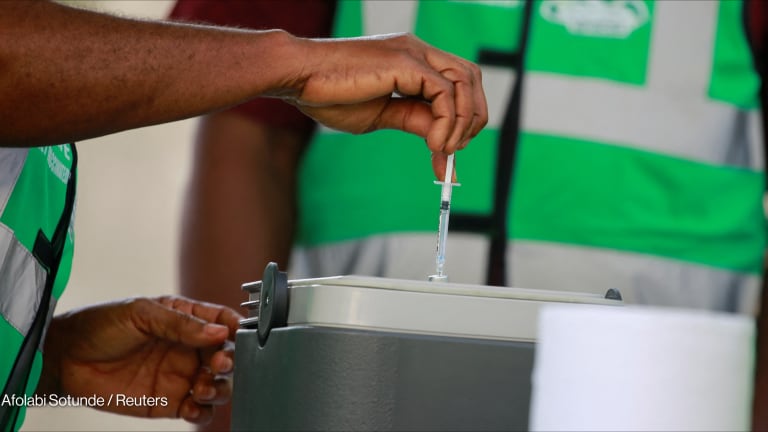
Vaccine hesitancy continues to pose challenges in COVID-19 vaccination efforts. But there are ways countries can increase vaccine uptake, according to a coalition that aims to boost vaccine confidence in Asia-Pacific.
The Asia Pacific Immunization Coalition, which makes use of evidence-informed research, policy, and advocacy to increase immunization resilience and vaccine confidence in the region, recently published a paper together with MSD and L.E.K Consulting that explored what worked and what was missing in communication strategies to boost COVID-19 vaccinations in the region. The report included interviews with immunology and public health experts from India, Indonesia, and the Philippines.
The must-read weekly newsletter for exclusive global health news and insider insights.
“Vaccine hesitancy should not be considered an ‘evil,’ which is what is happening in certain circles … because of how polarizing the issue has become,” Ananta Seth, assistant manager of the Asia Pacific Immunization Coalition and one of the paper’s co-authors, told Devex.
The coalition’s “best-practice framework” for an effective vaccination campaign includes carrying out surveys to understand what’s driving vaccine hesitancy among the population; involving local leaders and communities in developing communication plans and ensuring it is tailored to local contexts; educating key messengers such as health care workers for effective communication and not just focusing on the scientific content; ensuring there is consistent messaging across government; and real-time or near real-time monitoring of misinformation.
Seth also pointed out the importance of integrating monitoring and evaluation in vaccine communication strategies, finding the right messengers in a given context, partnering with the private sector, and the need to ensure the communication strategy is rooted in empathy.
“It has to be understood that vaccine hesitancy is a spectrum or a continuum. There are not only people who simply unquestionably accept vaccines or unquestionably refuse vaccines. Most people are somewhere in between,” Seth said.
Understand the hesitancy
Not everyone is anti-vaccines. In the state of Uttar Pradesh in India, the local government worked with village heads, health workers, and health activists to go door-to-door to urge people to get vaccinated for COVID-19. In doing so, they found that one of the biggest reasons why people were hesitant to get vaccinated was due to perceived inconvenience in accessing the vaccine, and complacency. The vaccination centers were quite accessible, but people, particularly marginalized groups, were unaware of their location.
“What this did was it helped increase awareness regarding accessibility of the vaccine, and … it took cognizance of the fact that the lack of mobility and convenience is an important contributing factor at times to vaccine hesitancy,” Seth said.
Fair price shops, set up to distribute food rations to people below the poverty line, also helped in educating people about the benefits of COVID-19 vaccines, and in guiding people to the nearest vaccination camps.
“It's very easy to kind of demonize, I think, a part of the community, or a part of the population, or certain elements in the population for rejecting vaccines. But it's more important to understand why they're doing that,” she added.
Tap the right messengers
It’s not enough that governments have detailed communication strategies. They should also find the right people to deliver the message. In Malaysia, the minister in charge of religious affairs assured the population — the majority of whom are Muslims — that the COVID-19 vaccines are permissible. Religious scholars also helped amplify the government’s messaging on the vaccines.
But governments should also pay careful attention to who to engage with.
The paper recommended engaging celebrities and social media influencers in raising awareness and in gathering the public’s support for vaccinations. The refusal of public figures to get vaccinated, such as the recent controversy involving tennis player Novak Djokovic, and how that affects people’s vaccine acceptance is “an interesting, relevant and timely research topic,” Seth said. However, it’s not a question they’ve tackled in the paper.
“There are not only people who simply unquestionably accept vaccines or unquestionably refuse vaccines. Most people are somewhere in between.”
— Ananta Seth, assistant manager, Asia Pacific Immunization CoalitionSeek partnerships with the private sector
The pandemic has stretched government resources and capacities, but they can help expand that and fill gaps in building vaccine confidence and getting people to take the jab by working with the private sector.
In Singapore, the government and online social network TikTok, a popular online platform for youth, partnered to encourage its users to get vaccinated for COVID-19.
In Malaysia, the government and the private sector have implemented a program called PIKAS to spearhead vaccinations among private employees in the manufacturing sector.
Employers can be a trusted source of vaccine information, but can also help increase vaccine uptake among their employees by hosting on-site vaccination clinics, creating incentives to get employees vaccinated, or providing paid time off for employees to get vaccinated, Seth said. One of the reasons people don’t get vaccinated is fear of losing a day’s wage if they miss work.
The private sector can also help in identifying what misinformation exists online, and in using artificial intelligence to generate the data and insights to inform communication and community engagement strategies, as well as improving demand for immunization, although this is currently a largely untapped opportunity, Seth said.
“These [AI] are technologies that have been used by even the commercial health care sector for a very long time to get insights into people's health-seeking behaviors. And so this is a huge kind of unexploited gap where governments are not really tapping into real-time or near real-time data monitoring to assess vaccine sentiments, which could be really helpful, especially in cases where there have been any rapid vaccine rollouts such as during the COVID 19 pandemic,” she said.









